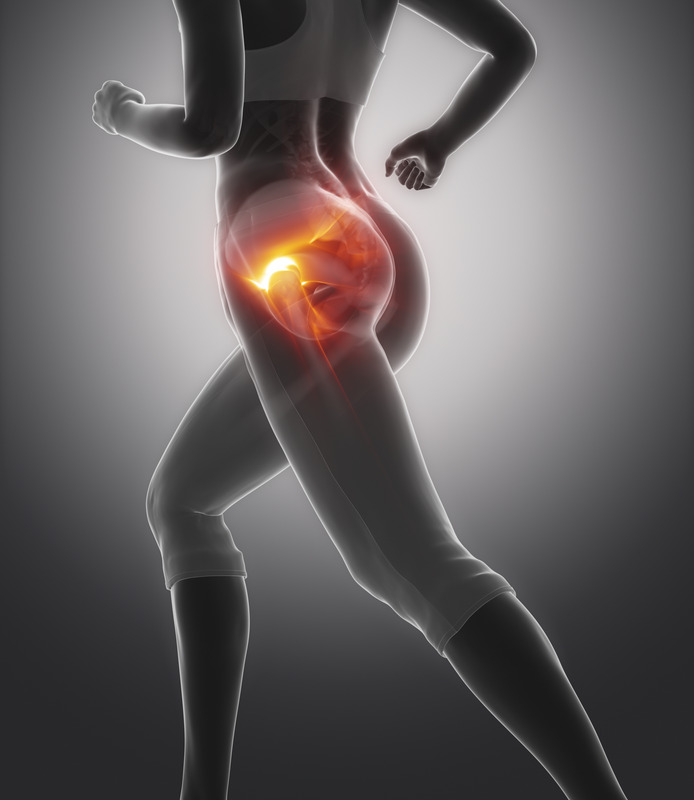Hip Arthritis
Hip arthritis is one of the most prevalent causes of hip pain. Arthritis is a progressive disorder, meaning that it usually begins gradually and worsens over time. The hip joint is a deep “ball and socket” joint that connects the leg to the pelvis. Confusion about the location of this joint is common. In common everyday usage, the term “hip” is applied to a bony ridge in the pelvis, which is more accurately termed the “iliac crest”.
The hip is a joint that is located much lower. It can be found in the location of the groin crease, where the leg attaches to the pelvis.
The ball of the hip joint is the “femoral head,” which rests within the “acetabulum” of the pelvic bone. The surfaces of both the ball and socket are covered with a 3–4 millimeter-thick layer of cartilage. The cartilage that lines the hip is an exceptional material. It is smoother than any man-made bearing. The cartilage has no nerve endings in it, and, therefore, any motion between cartilaginous surfaces does not cause pain.
What Is Hip Arthritis?
In a patient with arthritis, the cartilage wears away; the debris is generated, producing pain. As the cartilage wears away, the bone becomes exposed. The underlying bone does have nerve endings in it and is not a good-bearing material. As the exposed bone ends rub against each other, the nerve receptors in the bone are stimulated. This results in a greater pain sensation. Bone-on-bone pain is usually severe; the only solution at this point is some type of hip replacement.
You do not have to lose all of the cartilage in your joint to have severe pain; you just have to wear a section of the cartilage on both sides of the joint. Often, patients are told, “You still have some cartilage left, so you don’t need an operation.” This, of course, is not true.
Types of Hip Arthritis
Many types of hip arthritis may lead to degeneration of the hip joint. The most common form is osteoarthritis. It is not always known why some people will have worn out their joints at age 40 while others still have normal cartilage at age 70.
Most people with severe hip arthritis at a young age also have a hip deformity. The most common hip deformity in young men is cam FAI, while the most common hip deformity in young women is dysplasia. But genetic factors that affect cartilage quality and activity level may also play a role. 80% of men under 55 have cam FAI, and 30% of women under 55 have dysplasia.


Types of Arthritis
- osteoarthritis
- cam FAI
- pincer FAI
- profunda acetabulum
- protrusio acetabuli
- acetabular retroversion
- post-traumatic (following fracture or dislocation)
- rheumatoid arthritis
- other inflammatory hip arthritis (AS, IBD, Psoriatic)
- osteonecrosis (avascular necrosis,) or Legg Perthes disease (bone collapse due to loss of blood supply)
- congenital dysplasia (child with hip deformity)
- SCFE (slipped growth plate)
From its early, mild stages to its worst, crippling ones, hip arthritis usually gets worse over time. Initially, the pain occurs only after higher levels of activity. Later, it progresses and may become present at rest as well. Physical disabilities include a limp, muscle spasms, limited walking ability, less movement and stiffness, and the need for a cane, walker, or even a wheelchair. The level of symptoms may fluctuate, but, generally, they worsen with time.
In its early stages, hip arthritis can usually be treated with medicine, aids, and changes to how you do things. However, as the cartilage on both sides of the joint wears away completely and the bone rubs on the bone, arthritis has become “severe.” At this point, a hip replacement is often the only way to get rid of the pain. Even though there are many ways to treat the symptoms of arthritis, there is no scientific evidence that any treatment can stop cartilage from getting worse or grow back cartilage that has been lost.
Non-Operative Treatment
first
Your content goes here. Edit or remove this text inline or in the module Content settings. You can also style every aspect of this content in the module Design settings and even apply custom CSS to this text in the module Advanced settings.
Activity Modification
As a general guideline, low-stress activities that are usually tolerated well are short-distance walking, exercising on a bicycle, swimming, and water aerobics. High-stress activities (which are not advised) would include jumping, jogging, long-distance walking (> 1 mile), or heavy lifting.
With the improvement of surgical techniques and implants, it is reasonable to replace hips so active patients can return to high-level activity such as running. An individual must weigh the risks of surgery against his or her desire to participate in sports or heavy work.
Weight Loss
Supportive Device
Cane, Crutch, Walker
Another way to decrease the force is to use a cane or crutch on the opposite hand. This makes it easier for the muscles around the hip to move less when walking and takes a few hundred pounds of force off the hip. Braces are not effective in the treatment of hip arthritis.
Exercise
Heat
first
Your content goes here. Edit or remove this text inline or in the module Content settings. You can also style every aspect of this content in the module Design settings and even apply custom CSS to this text in the module Advanced settings.
Glucosamine
But it is often sold as a way to rebuild cartilage that has been lost, even though there is no scientific evidence for this. It does take 2-3 months of regular use of this material before it “gets into your system” and relieves arthritis pain.
If your symptoms don’t get better after two to three months, you probably shouldn’t keep taking this supplement. The usual recommended dosage is 1500 milligrams per day.
Tylenol
Non-steroidal Anti-inflammatory Medications (NSAIDs)
There are probably 25–30 of these types of medications on the market today. Each company claims the superior effectiveness of its brand. Sometimes one brand, as opposed to another, may seem to work better for one individual. However, generally speaking, they are all equally effective. The newer brands are usually advertised more vigorously and carry a higher price tag.
The earlier brands (Ibuprofen and Naproxen) are no longer under patent and can be purchased much more inexpensively and often at lower doses as an over-the-counter formulation. Sometimes, for unclear reasons, one may work better for an individual. However, if you have tried 2-3 of these and have had inadequate relief, there is no value in testing others. The most common side effects of these are gastrointestinal (GI) irritation and bleeding. Rarely, kidney or liver damage can occur.
Celebrex is a unique “COX-2” inhibitor. Its efficacy in treating arthritis pain is no different from all of the other NSAIDs. However, this drug is much less likely to cause GI irritation or bleeding than other NSAIDs. This drug also doesn’t affect how platelets work to stop bleeding, so people who take blood thinners (anticoagulants) can take it safely. It also does not interfere with the therapeutic anti-platelet action of aspirin as the other NSAIDS do. As a result, patients who are taking aspirin to prevent heart attacks and strokes may benefit more from Celebrex than other NSAIDs.
There were two other “COX-2” inhibitors previously on the market that were recalled by the FDA. Vioxx was found to have a higher rate of cardiac complications than other NSAIDs. Bextra rarely causes a severe skin reaction called Stevens-Johnson syndrome. Although Celebrex is also a “COX-2” inhibitor, it causes no more cardiac problems than other NSAIDS and may well be safer than other NSAIDs in patients who need to take aspirin for clot prevention.
Celebrex is still patented, so it costs a lot more (about $100 per month) than other NSAIDS because it is still protected by a patent. Despite its proven better safety, insurance companies often place pressure on patients to use a less safe option. If you can’t afford Celebrex, Mobic is the closest substitute as a mixed COX-1/COX-2 inhibitor. It is available as a cheap generic.
Other combination medicines, including an NSAID plus a stomach protector, are now available. Another strategy is to use over-the-counter Prilosec as a stomach protector.
Steroid Injections
Viscosupplementation
Alternative treatments like magnets, wraps, devices, herbs, and prolotherapy that haven’t been proven to work may work because of the placebo effect.
Are you experiencing hip pain and discomfort?
Contact us to schedule an appointment to speak with one of our orthopedic doctors at one of our locations near you or give us a call at (803) 256-4107.
Preoperative Office Visit
Within the last week or two before surgery, we will ask you to see us in the office for a final check before surgery. We will review your preparation, make sure all of your questions are answered, and finalize our management plan.
We will ask you to purchase crutches, an ice machine, and a hip device kit for a reasonable price at this time if you don’t already have these. We will teach you how to use them. We will provide you with all of the prescriptions that you need after hospital discharge. We strongly recommend that you fill them out in advance at Long’s Pharmacy, across the street from the hospital.
They keep all of the medications that we use in stock, so it is convenient. Not infrequently, insurance companies create hassles and delays when you try to fill a prescription. If you start the process early, these insurance company tricks will be taken care of before you leave the hospital. We want your discharge to run smoothly. In addition, it is important to realize that most narcotic prescriptions must be filled here in South Carolina; the law does not allow pharmacies in other states to fill them.
Patients from out of state will get a full orthopedic evaluation. We will get specialized x-rays that are up-to-date and help us place your implants correctly during surgery. We will answer all of your and your caregivers’ final questions at this time.
